
The iron ore price has remained relatively range bound this year – trading between US$95-105/tonne – broadly in line with its long-term historical average.
Market fundamentals have been surprisingly resilient this year, as supply has been disrupted by weather events while demand has been relatively robust, which has driven inventories lower and supported the iron ore price.
Earlier this week, the iron ore price rose to a four-month high of ~US$104/tonne, after China unveiled a 1.2 trillion yuan (A$257bn) hydropower project in Tibet, which has provided a boost to an otherwise subdued outlook for materials demand. Separately, there are hopes that Beijing’s continued efforts to curb excess capacity in the steel sector could improve mill margins and support raw materials pricing.
Nonetheless, the market is expected to move into a surplus in the second half of this year, which should widen over the medium-term. Steel demand remains challenged by structural issues in China’s property sector, as well as the ongoing US-China trade uncertainties, while iron ore supply is expected to grow as supply disruptions subside and major projects (particularly Simandou - explored below) come online.
The softening in the supply/demand balance is expected to place downward pressure on the iron ore price towards the marginal cost of production, with cost support currently estimated at ~US$85/tonne (based on the 90th percentile of the global cost curve). Consensus forecasts reflect this view, with average prices of US$92/tonne in FY26e and US$87/tonne in FY27e.
With risks still skewed to the downside, the Focus Portfolio remains modestly underweight iron ore (8% weighting vs the ASX 300 at 10.3%).
In this report, we unpack our cautious stance on the commodity, examine the evolving commodity exposures of Australia’s iron ore majors, and reaffirm our preference towards BHP as our sole exposure within the sector.
We also flag recent portfolio changes, namely the upweighting of Sandfire Resources and trimming of Macquarie Group. The iron ore price has remained relatively range bound this year – trading between US$95-105/tonne – broadly in line with its long-term historical average.
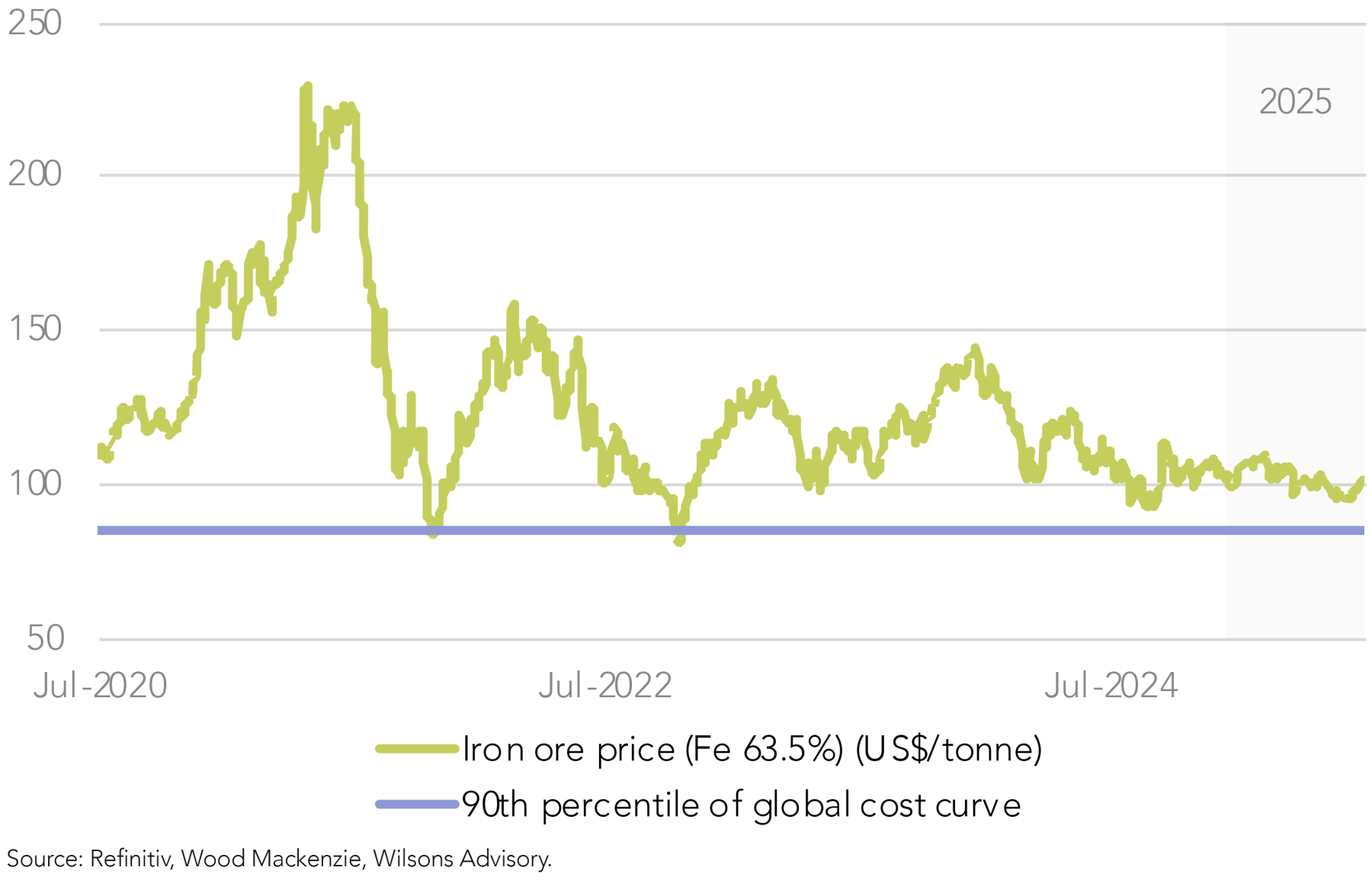
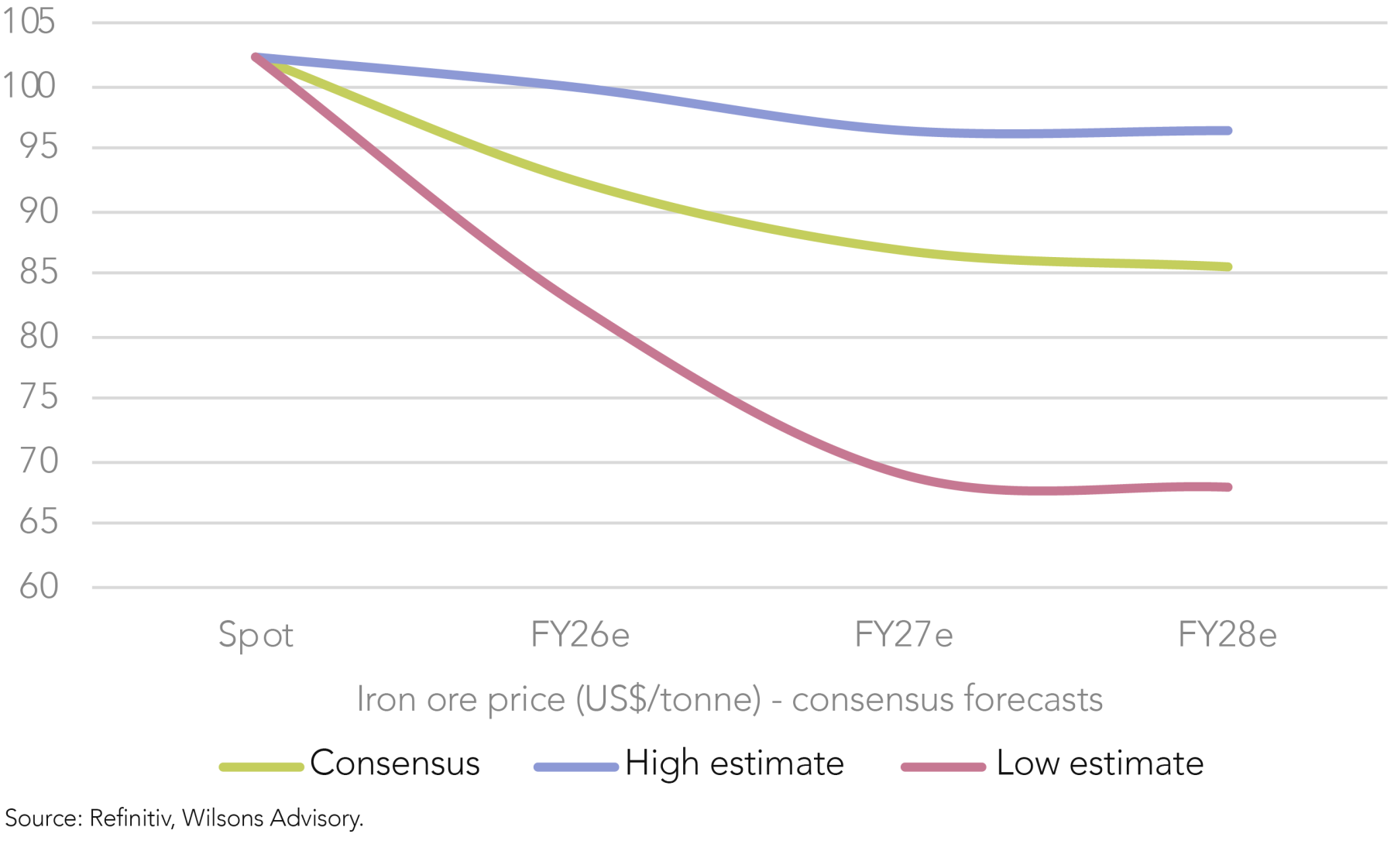
Iron Ore Demand Faces Structural Headwinds
The medium/long-term outlook for iron ore demand faces structural headwinds, including China’s housing oversupply and unfavourable demographic changes, which continue to be reflected in key economic indicators.
In China, manufacturing and steel PMIs have been below the 50 threshold – indicating contraction – for most of the past year. Meanwhile, steel production remains subdued, housing starts and turnover are down 20% and 15% YoY respectively, and new home prices have been in a two-year downtrend.
The recent China Urban Work Conference marked a shift in urbanisation policy, with an emphasis on upgrading existing housing and infrastructure rather than building new cities. As upgrades typically require less steel than new construction, this shift points to structurally softer demand for iron ore.
Accordingly, we continue to expect weaker property and construction activity, alongside subdued growth in machinery and equipment manufacturing due to trade tensions, to drive a gradual decline in Chinese steel (and therefore iron ore) demand over the medium-term. This decline is likely to accelerate into the 2030s as demographic pressures, including an ageing and shrinking population, intensify.
Given the weak outlook for China’s real estate sector, expectations for targeted policy support are building. Measures may include easing purchase restrictions and cuts to transaction taxes to stabilise near-term construction activity and iron ore demand. However, such stimulus is unlikely to address the deep-rooted structural challenges facing China’s economy.

A Glut of Low-Cost Supply is on the Horizon
Simandou, which has been referred to as the ‘Pilbara Killer’, is the world’s largest and highest-grade undeveloped iron ore deposit. The project is set to materially increase global supply over the medium-term, with first production expected by the end of 2025. Divided into Simandou North and South, the asset contains an estimated four billion tonnes of recoverable ore, with planned production capacity of 120 Mtpa and grades of 65–67% Fe.
When the project reaches full capacity, expected around 2030, it is projected to account for 6–7% of global seaborne iron ore supply. This represents a substantial influx of new supply into an already oversupplied market.
Simandou is expected to be among the lowest-cost and highest-grade iron ore assets globally, with operating costs competitive with or slightly below Australia’s Pilbara mines.
The addition of new low-cost supply threatens to displace higher-cost output from marginal producers, thereby lowering the global iron ore cost curve and reducing the price floor.
Moreover, the project’s high-grade output is likely to compress the premium historically enjoyed by Australian high-grade producers (BHP and Rio), which could result in lower realised prices.
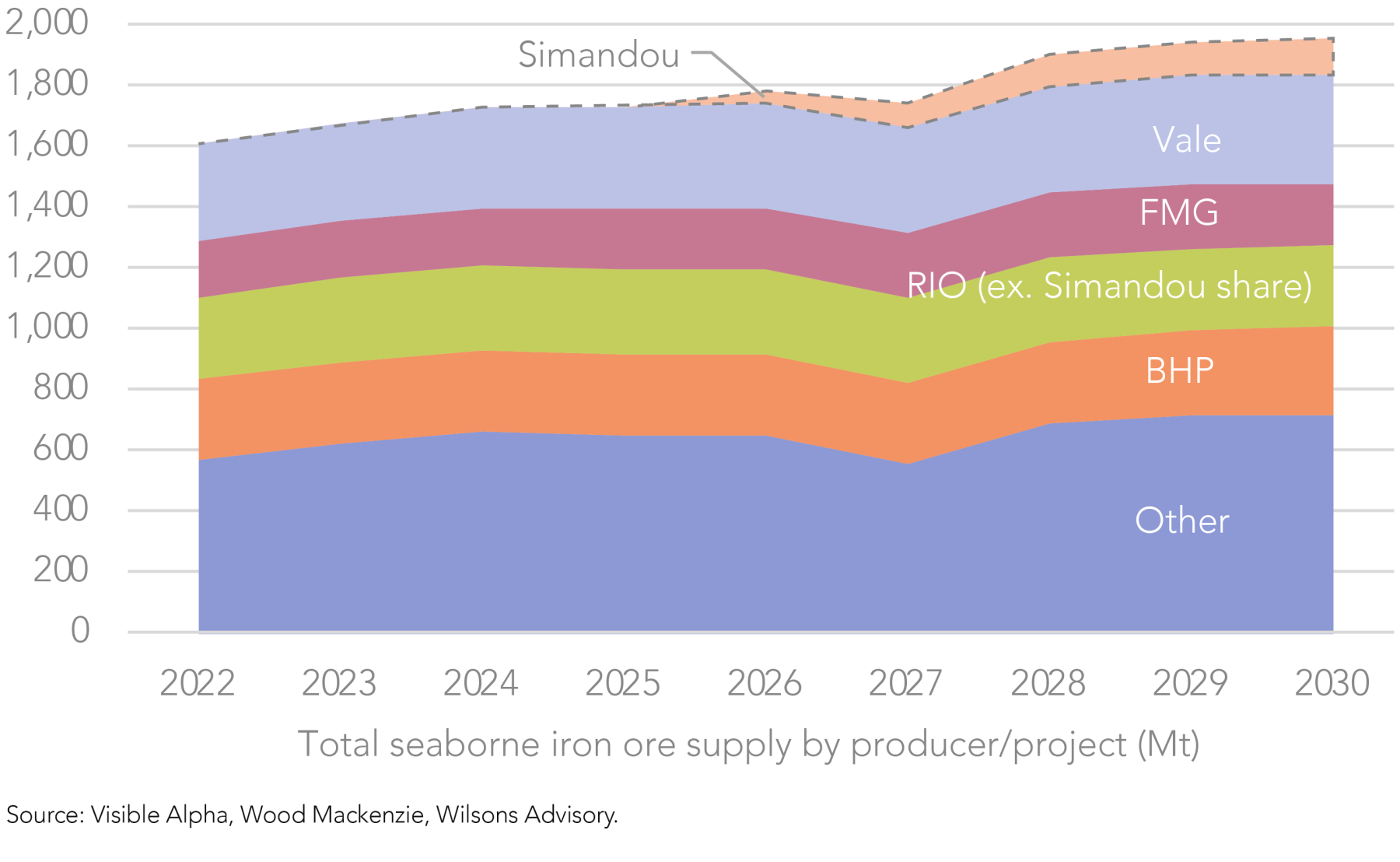

Oversupply to Grow, Prices to Fall
All things considered, we maintain a cautious stance on iron ore, underpinned by the soft demand outlook and incremental supply growth driven by the ramp-up of the Simandou project. We expect this to drive a growing surplus and lower iron ore prices over the medium term. The key near-term risk to this view is the potential for stronger-than-expected stimulus from China. However, our base case remains that policy support will primarily focus on stabilising the property market, while doing little to address the long-term structural challenges facing China’s economy.
In any case, we expect that incremental stimulus measures would likely trigger a broad-based commodity rally – in line with the resources sector rally seen between 10–30 September 2024, which followed Chinese stimulus announcements (Figure 7). Importantly, the Focus Portfolio is well positioned for such a scenario, with an overweight to resources overall, driven by our overweight exposures to copper (via Sandfire Resources) and aluminium (via South32), as well as our weighting in BHP.
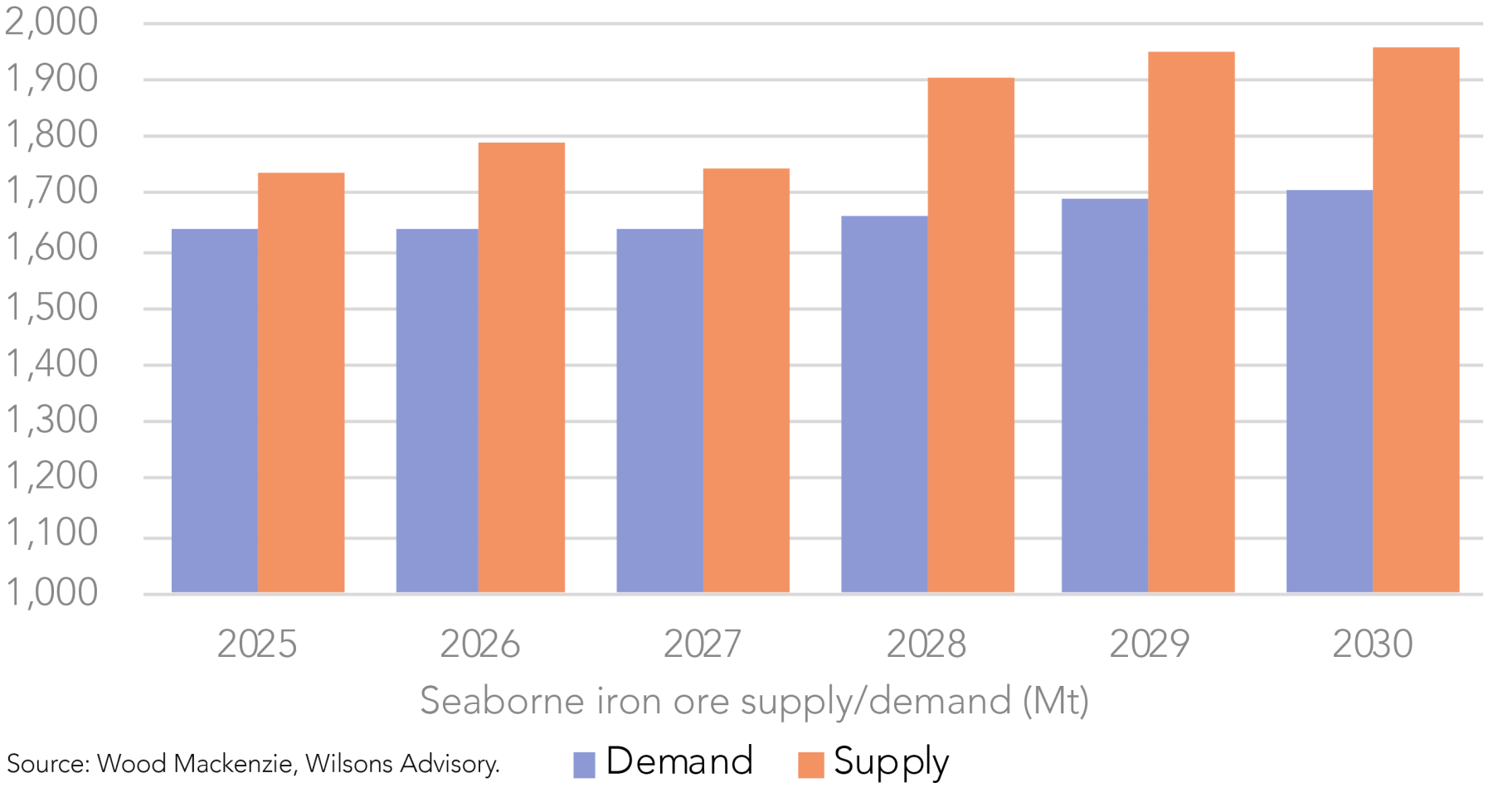

BHP and Rio are More than Just ‘Iron Ore Plays’
Over the past five years, BHP (BHP) and Rio Tinto (RIO) have pursued both M&A and organic growth strategies to diversify their commodity exposures, with a clear focus on future-facing commodities. Noteworthy examples include BHP’s acquisition of OZ Minerals (copper) and Rio’s acquisition of Arcadium Lithium (lithium) - both of which were previously held in the Focus Portfolio prior to being taken over.
Since FY20, BHP’s EBITDA composition has shifted meaningfully. Copper’s contribution has more than doubled, rising from 19% to a forecast 40% in FY25e, while iron ore has declined from 64% to 57%. Rio has undergone a similar transformation, with iron ore’s EBITDA share falling from 76% to 57%, while copper and aluminium have each doubled to 20% and 18%, respectively.
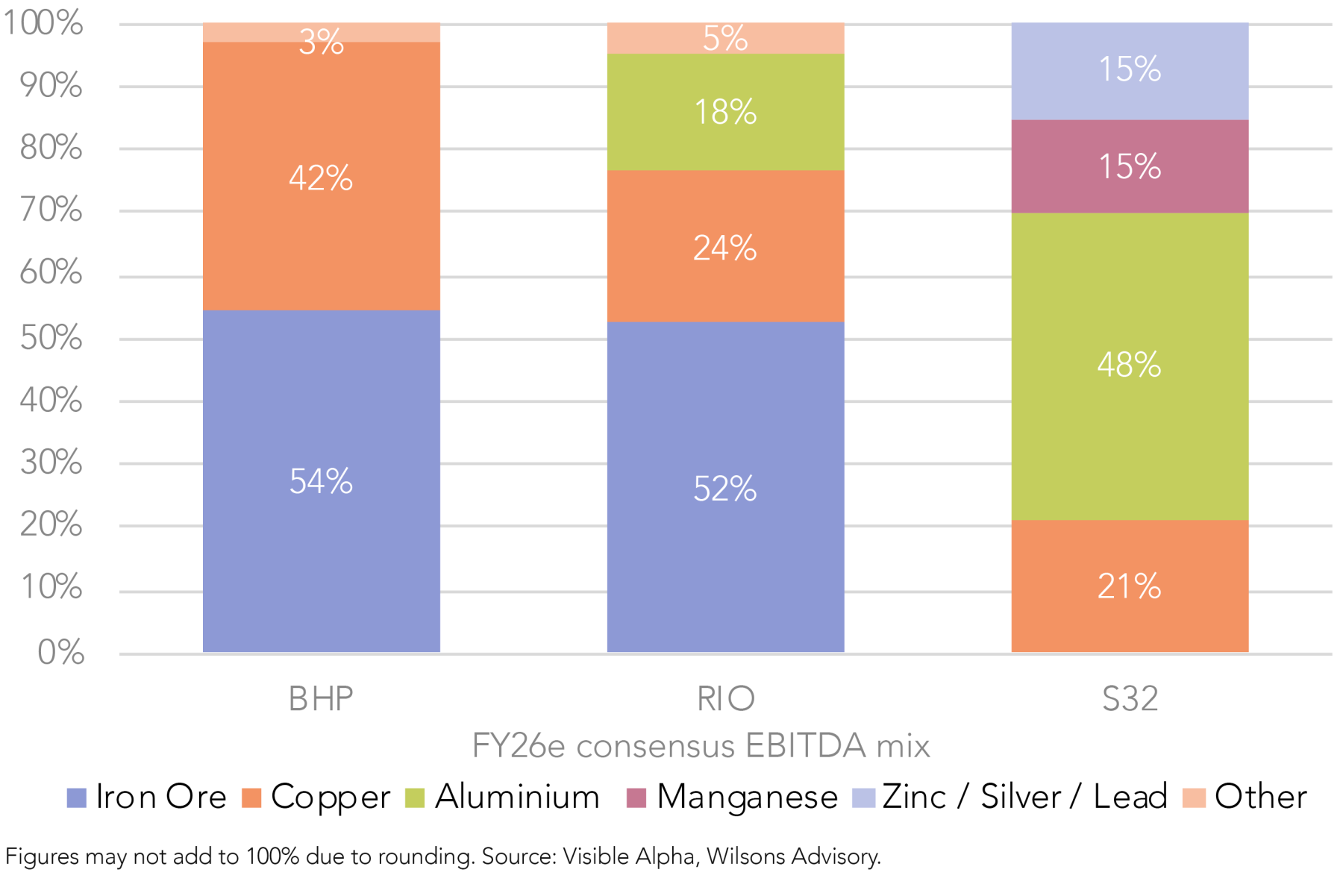
Importantly, this evolving commodity mix is increasingly being reflected in share price performance. Over the past two years, the total returns of both companies have broadly tracked their underlying commodity baskets, rather than moving in lock step with the iron ore price, as shown in Figures 10 and 11. Interestingly, during this timeframe, both BHP and Rio actually exhibited a higher copper beta than iron ore beta (Figure 9). This arguably reflects the scarcity of large, liquid, pureplay copper exposures on both the ASX and offshore indices, as well as growing investor interest in the commodity.
| Copper | Iron Ore | Aluminium | |
| BHP | 0.6 | 0.5 | |
| RIO | 0.7 | 0.5 | 0.6 |
| S32 | 1.1 | 0.8 |
Figure 9 is calculated using weekly data from the last two years. Source: Refinitiv, Wilsons Advisory.
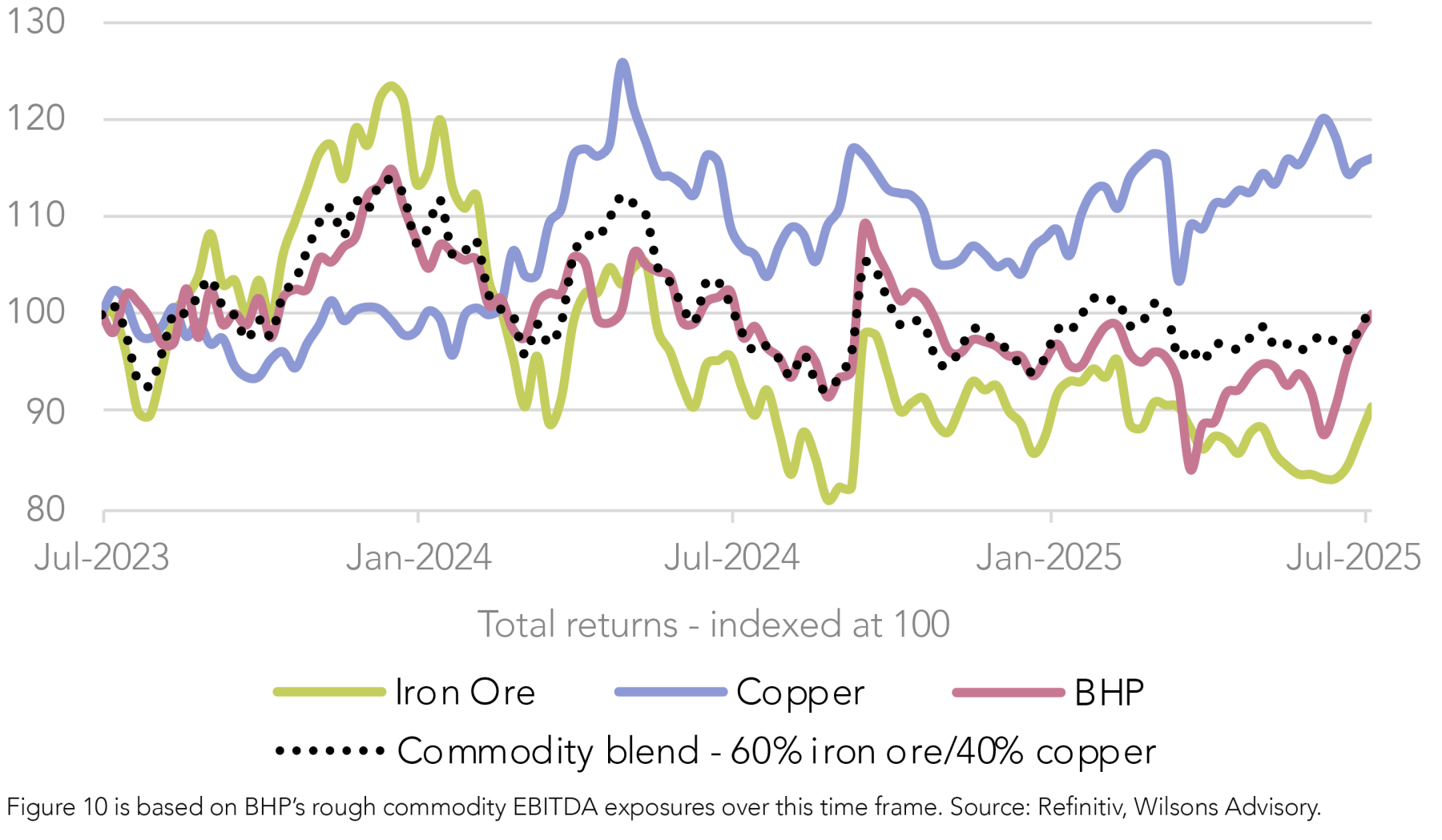
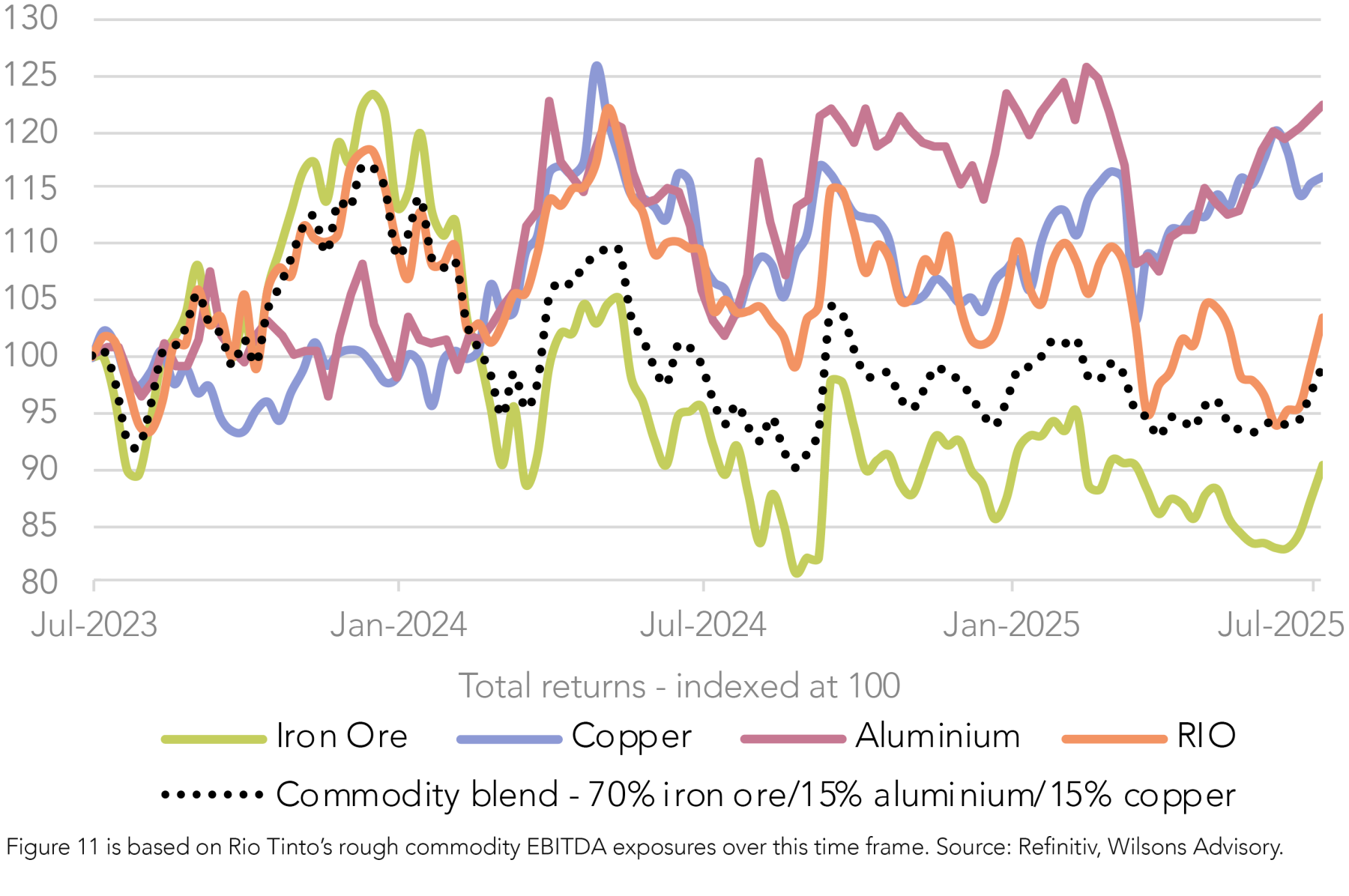
BHP > Rio Tinto
BHP remains our preferred iron ore exposure and is held in the Focus Portfolio at a weighting of 8%, which represents a neutral position (vs ASX 300 weighting of 7.6%).
Our preference towards BHP over Rio Tinto is driven by three key considerations:
1. Consistent delivery
BHP has demonstrated a relatively strong track record in meeting production guidance and managing ESG considerations. In contrast, Rio Tinto has experienced more frequent production downgrades and operational disruptions in recent years (e.g. mine heritage management issues and delays at projects like Gudai-Darri). Rio has also faced significant ESG controversies, most notably the destruction of Juukan Gorge. In addition, Rio's major growth projects – Simandou (Guinea) and Oyu Tolgoi (Mongolia) – introduce higher operational and jurisdictional risk, while the company’s ongoing leadership transition adds an element of near-term uncertainty.
2. Lowest-cost, highest-grade producer
BHP is the highest-margin iron ore producer globally, positioning it to generate superior free cash flow in a weaker price environment. As the lowest-cost producer, BHP has the least EBITDA leverage to the iron ore price among the major iron ore miners (see Figure 13), which is advantageous under our base case of continued price softness. In addition, BHP benefits from its high-grade operations, with Fe grades expected to remain stable at ~62% - in line with the benchmark and the highest among Australian producers. In contrast, Rio Tinto’s Pilbara division continues to experience Fe grade decline from a lower base of ~60–61%, eroding its pricing power and increasing exposure to discounts.
3. Superior commodity basket
BHP’s meaningful exposure to copper (see Figure 8) is appealing given our structurally positive stance towards the commodity, as a decarbonisation beneficiary poised for growing supply deficits. Due to its superior copper exposure, BHP has the highest EBITDA leverage to the copper price out of the major diversified miners, as shown in Figure 12. While Rio Tinto’s copper production is expected to grow most significantly over the medium-term, the commodity’s contribution to EBITDA is forecast to peak at ~28% by FY28 – well below BHP’s current copper EBITDA contribution, at ~40% of its mix.
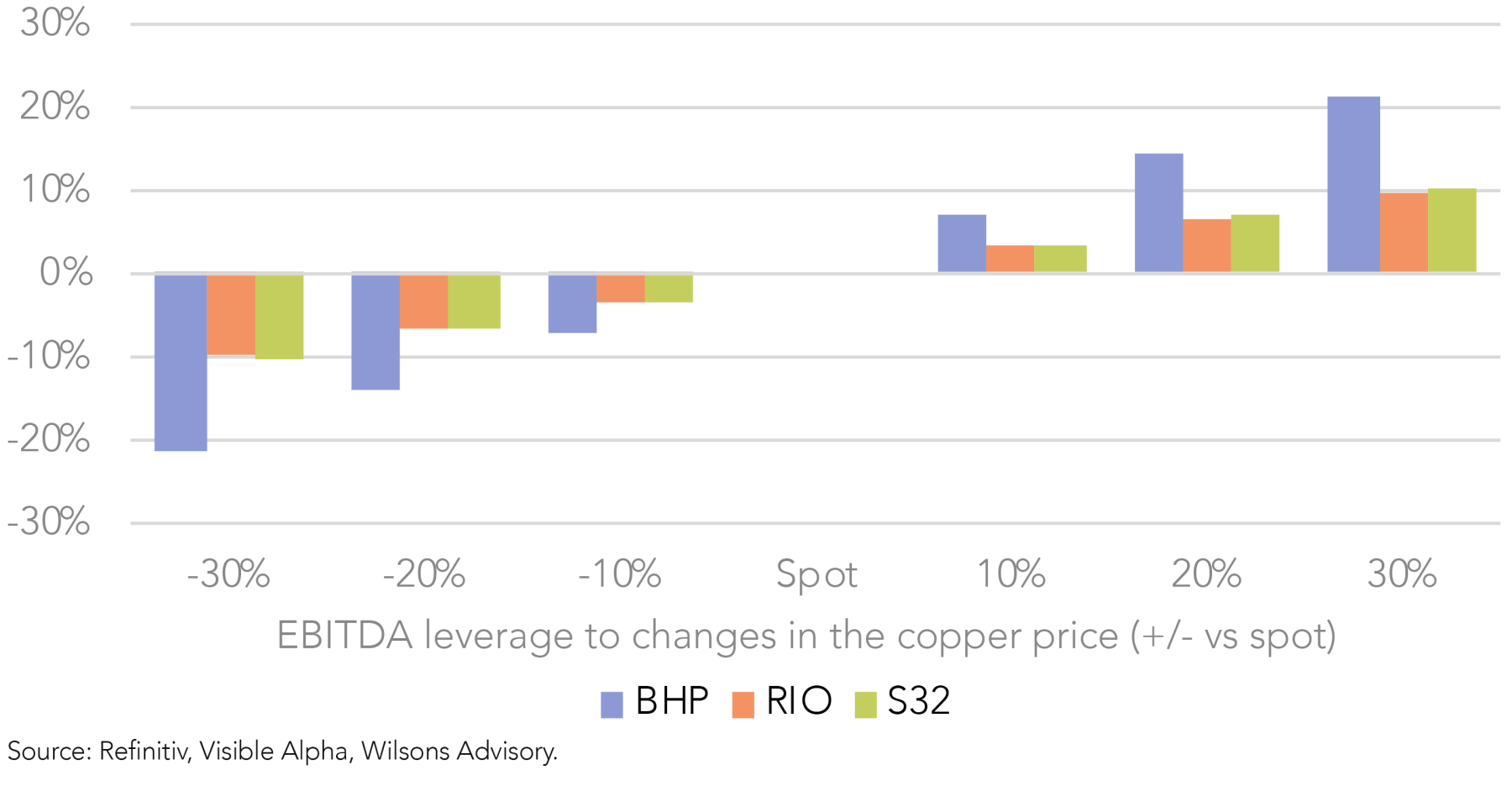
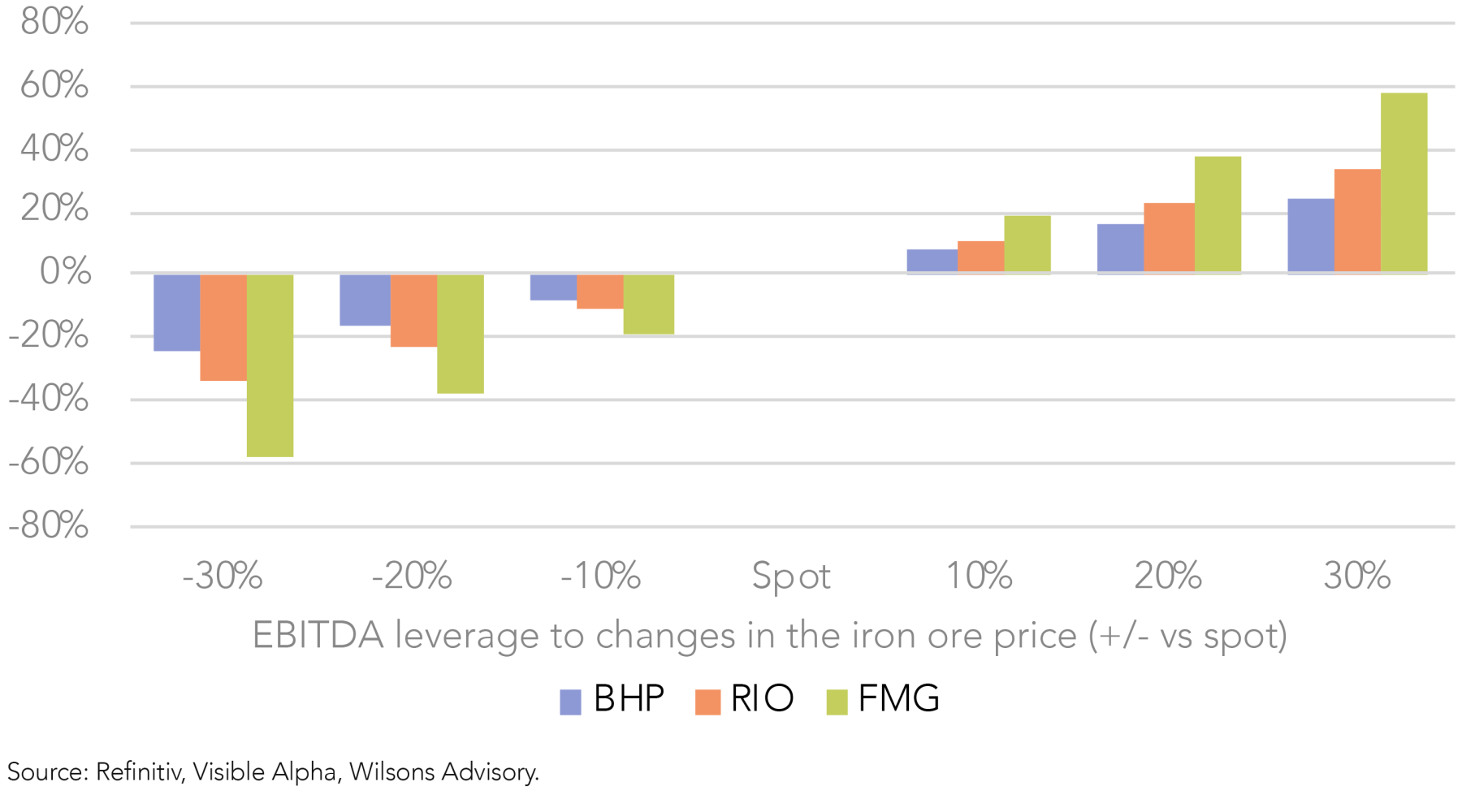
Adding to our Copper Exposure
Upweighting Sandfire Resources from 2% to 3%
Following the removal of MAC Copper (MAC) from the Focus Portfolio earlier this month after its binding takeover proposal from Harmony Gold, we are taking this opportunity to increase our weighting in Sandfire Resources (SFR) from 2% to 3%.
Our constructive medium-term outlook for copper remains unchanged. We continue to anticipate a growing supply deficit and a structurally rising cost curve, both of which support our view that copper prices are likely to trend higher over the medium to long term.
Recent softness in the sector driven by renewed US-China trade concerns has provided a compelling entry point to increase our position in SFR, bringing our copper and resources sector overweights closer to target.
Trimming Macquarie Group from 4% to 3%
We are neutralising our position in Macquarie Group (MQG), reducing its portfolio weighting from 4% to 3%, which aligns its weighting in the ASX 300. This follows a period of solid outperformance, with the stock returning +29% over the past three months, which has pushed its forward P/E to ~20x (+13% vs 5yr avg). Notwithstanding an improving outlook for MQG, ongoing macro uncertainty prompts caution around near-term consensus risks.

Written by
Greg Burke, Equity Strategist
Greg is an Equity Strategist in the Investment Strategy team at Wilsons Advisory. He is the lead portfolio manager of the Wilsons Advisory Australian Equity Focus Portfolio and is responsible for the ongoing management of the Global Equity Opportunities List.
About Wilsons Advisory: Wilsons Advisory is a financial advisory firm focused on delivering strategic and investment advice for people with ambition – whether they be a private investor, corporate, fund manager or global institution. Its client-first, whole of firm approach allows Wilsons Advisory to partner with clients for the long-term and provide the wide range of financial and advisory services they may require throughout their financial future. Wilsons Advisory is staff-owned and has offices across Australia.
Disclaimer: This communication has been prepared by Wilsons Advisory and Stockbroking Limited (ACN 010 529 665; AFSL 238375) and/or Wilsons Corporate Finance Limited (ACN 057 547 323; AFSL 238383) (collectively “Wilsons Advisory”). It is being supplied to you solely for your information and no action should be taken on the basis of or in reliance on this communication. To the extent that any information prepared by Wilsons Advisory contains a financial product advice, it is general advice only and has been prepared by Wilsons Advisory without reference to your objectives, financial situation or needs. You should consider the appropriateness of the advice in light of your own objectives, financial situation and needs before following or relying on the advice. You should also obtain a copy of, and consider, any relevant disclosure document before making any decision to acquire or dispose of a financial product. Wilsons Advisory's Financial Services Guide is available at wilsonsadvisory.com.au/disclosures.
All investments carry risk. Different investment strategies can carry different levels of risk, depending on the assets that make up that strategy. The value of investments and the level of returns will vary. Future returns may differ from past returns and past performance is not a reliable guide to future performance. On that basis, any advice should not be relied on to make any investment decisions without first consulting with your financial adviser. If you do not currently have an adviser, please contact us and we would be happy to connect you with a Wilsons Advisory representative.
To the extent that any specific documents or products are referred to, please also ensure that you obtain the relevant disclosure documents such as Product Disclosure Statement(s), Prospectus(es) and Investment Program(s) before considering any related investments.
Wilsons Advisory and their associates may have received and may continue to receive fees from any company or companies referred to in this communication (the “Companies”) in relation to corporate advisory, underwriting or other professional investment services. Please see relevant Wilsons Advisory disclosures at www.wilsonsadvisory.com.au/disclosures.
